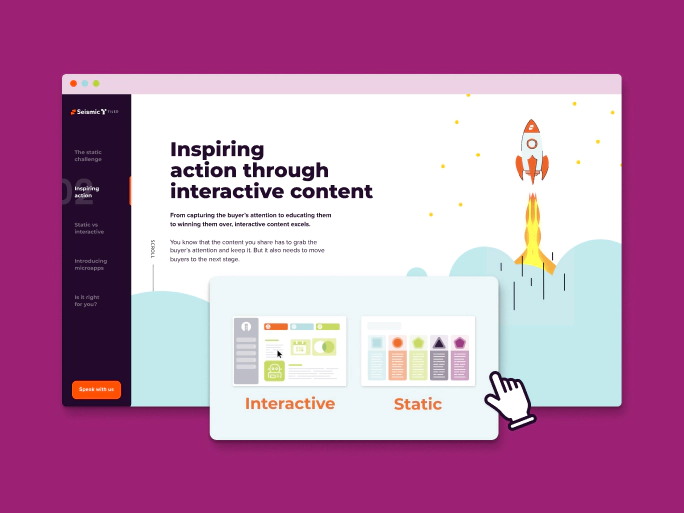What are sales documents?
Sales documents are written materials that are used in the sales process to communicate information and facilitate transactions between buyers and sellers. These resources — which are also known as sales collateral or sales assets — help reps move buyers through the sales funnel. They convey value, build trust, and provide the information a prospect needs to know when deciding whether or not to buy a product or service.
Ideally, frontline teams have access to many types of sales documents for their buyers’ various needs and stages. Common examples of sales documents include:
- Pricing documents: One of the most fundamental of all sales assets, a pricing document outlines the cost structure and financial terms associated with a product or service. One excellent resource is a sales contract template that outlines the terms and conditions of a sale, including payment details and a detailed breakdown of the pricing structure. Sales documents like these offer potential buyers an overview of expected expenses.
- Case studies: Case studies focus on the success of a customer who is currently using the product or service a prospect is considering. It details the challenges the customer faced, the solution implemented, and the positive results achieved.
- Product demos: Sales reps use product demos to showcase the features, functionality, and benefits of a product to potential customers. Product demos can be delivered in written formats and through other channels, such as webinars, video tutorials, or interactive online platforms.
- Competitive battle cards: These are the most strategic item every sales organization should have in its list of sales documents. Competitive battle cards are used internally and They equip sales teams with valuable insights of market competitors so they can make informed decisions when engaging with customers or prospects.
The role of sales documents in the sales process
Sales documents play a critical role throughout the sales process. Done right, they not only provide essential information about a product or service but also address a potential buyer’s specific concerns, offering tangible evidence of the benefits that can be expected from the proposed solution. Aligning sales documents with each stage of the buyer’s journey establishes trust and confidence, ultimately increasing the likelihood that a prospect will convert to a sale.
To better understand the role sales documents play in the sales process, consider a scenario in which a technology company is trying to secure a deal with a potential client in the healthcare industry. The client needs a software solution that can streamline data management and improve operational efficiencies.
In this context, a well-crafted case study can be highly effective. In an ideal world, this case study would feature a current customer who faced similar challenges to the potential buyer. It would also include details about how the technology company’s software was successfully implemented, the specific problems addressed, and the positive outcomes achieved.
This example illustrates just one of the many uses of sales documents. Incorporating a case study and other relevant sales documents at key points in the sales cycle significantly enhances a seller’s ability to connect with prospects and demonstrate the practical value of their solution. Ultimately, this leads to faster deal cycles and increased win rates.
The connection between enablement and sales documents
Because sales documents are so vital for winning deals, sellers need easy access to them. That’s where sales enablement comes in. Sales enablement centralizes sales documents, ensuring that the latest, most relevant resources are at sellers’ fingertips. That way, sales reps don’t have to waste time searching for the right assets or worrying about which version is the most up-to-date — approved materials are quickly discoverable and ready to use.
In addition to organization and accessibility, sales documents must be customized according to each buyer’s unique needs, challenges, and objections. Sales enablement tools help sellers tailor their pitches to each buyer, contributing to a positive customer experience. Prebuilt templates with approved messaging and customization options enable sellers to quickly personalize presentations for maximum impact.
Today’s sales enablement tools also provide organizations with the insights and data needed to understand content effectiveness. Robust analytics assist enablement leaders in tracking internal content usage while helping frontline teams identify buyer preferences.
In a nutshell, sales enablement empowers sellers to use sales resources strategically and enhance their effectiveness. It optimizes the entire document lifecycle from discovery to delivery and unlocks the full potential of your sales team to connect, convince, and close deals.
Sales Content Reimagined

Best practices for sales documents
Sales documents can vary widely in performance. The most effective ones are well-crafted, compelling, and delivered at the right time. For guidance, here are five best practices to keep top of mind as you prep sales documents and fine-tune your sales documentation process:
Tailor sales documents
Customizing sales documents to resonate with each prospect’s needs, challenges, and interests is essential. First, gather insights into specific pain points, industry trends, and preferences. Then, personalize the content to demonstrate that you understand their business and how your product or service will address their unique challenges.
Map documents to the buyer’s journey
A well-stocked sales document repository has resources that align with each stage of the buyer’s journey (awareness, consideration, decision). Recognize where your prospects are in the sales funnel and use your sales documents accordingly, anticipating common objections at each stage.
Use interactive content
While multimedia elements such as videos and infographics make your sales documents visually appealing, interactive content is even more engaging and memorable. For example, interactive quizzes or assessments offer prospects insights into their needs or challenges. The answers provided can also be used to improve customization.
Track and measure effectiveness
Analytics tools demystify how prospects are interacting with your sales documents. You can monitor a wide range of metrics, including time spent on each page, click-through rates, and document downloads. Feedback like this will help you identify which elements are most effective, as well as those that could be improved.
Leverage a sales enablement tool
Implementing a sales enablement platform to centralize all your sales documents ensures that your sales team has easy access to the latest and most relevant materials. Sales enablement streamlines the distribution process and maintains version control to ensure that everyone is aligned and using the most up-to-date materials.
Incorporating these best practices into the preparation of sales documents and your sales documentation process can enhance the effectiveness of your sales strategy overall, helping your teams achieve growth.
Save 360+ hours a year with Seismic.
Deliver the right sales docs at the right time
At Seismic, we make it easy for clients to organize a central hub for sales documents for quicker discovery, personalization, distribution, and tracking. Our sales enablement solution ensures sellers are equipped with the knowledge and resources needed to deliver the right sales documents at the right time. To learn more, check out Seismic in action by watching these short, led-by-you demos that address common sales challenges.



